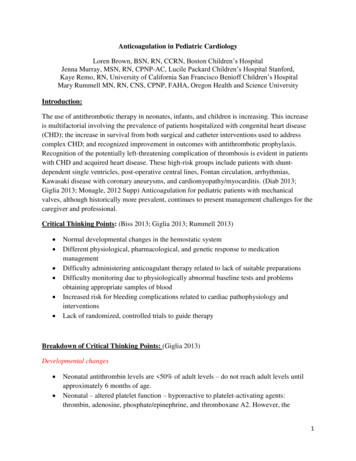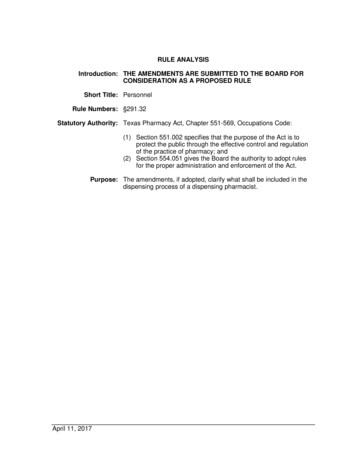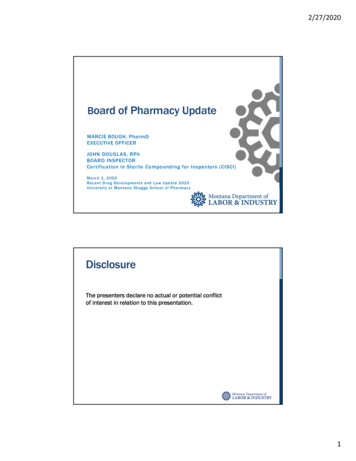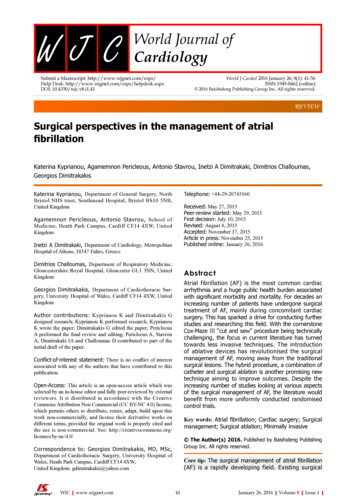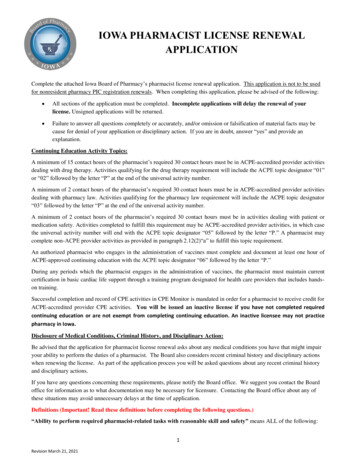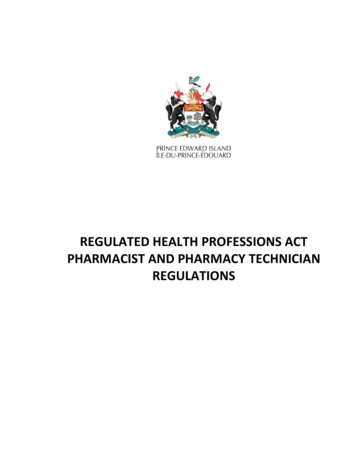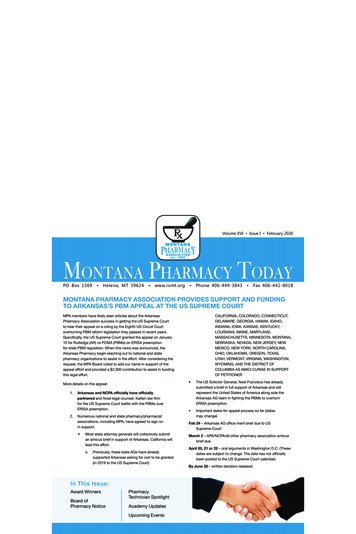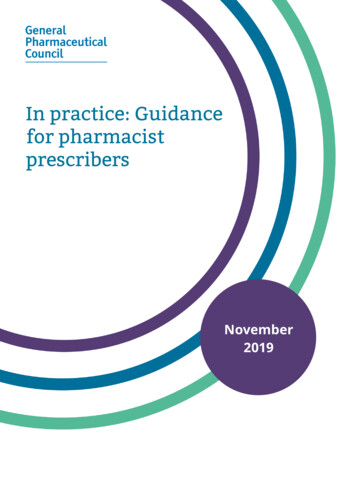
Transcription
Young et al. BMC Family Practice 2011, ESEARCH ARTICLEOpen AccessComparison of pharmacist managedanticoagulation with usual medical care in afamily medicine clinicStephanie Young1*, Lisa Bishop1,2, Laurie Twells1,2, Carla Dillon1,2, John Hawboldt1,2 and Patrick O’Shea2,3AbstractBackground: The beneficial outcomes of oral anticoagulation therapy are dependent upon achieving andmaintaining an optimal INR therapeutic range. There is growing evidence that better outcomes are achieved whenanticoagulation is managed by a pharmacist with expertise in anticoagulation management rather than usual careby family physicians. This study compared a pharmacist managed anticoagulation program (PC) to usual physiciancare (UC) in a family medicine clinic.Methods: A retrospective cohort study was carried out in a family medicine clinic which included a clinicalpharmacist. In 2006, the pharmacist assumed anticoagulation management. For a 17-month period, the PC group(n 112) of patients on warfarin were compared to the UC patients (n 81) for a similar period prior to 2006. Theprimary outcome was the percentage of time patients’ INR was in the therapeutic range (TTR). Secondaryoutcomes were the percentage of time in therapeutic range within 0.3 units of the recommended range(expanded TTR) and percentage of time the INR was 5.0 or 1.5.Results: The baseline characteristics were similar between the groups. Fifty-five percent of the PC group was malewith a mean age of 67 years; 51% of the UC group was male with a mean age of 71 years. The most commonindications for warfarin in both groups were atrial fibrillation, mechanical heart valves and deep vein thrombosis. TheTTR was 73% for PC and 65% for UC (p 0.0001). The expanded TTR for PC was 91% and 85% for UC (p 0.0001).The percentage of time INR values were 1.5 was 0.7% for PC patients and 1.9% for UC patients (p 0.0001), and 5were 0.3% for PC patients and 0.1% for UC (p 0.0001).Conclusion: The pharmacist-managed anticoagulation program within a family practice clinic compared to usualcare by the physicians achieved significantly better INR control as measured by the percentage of time patients’INR values were kept in both the therapeutic and expanded range. Based on the results of this study, acollaborative family practice clinic using pharmacists and physicians may be an effective model for anticoagulationmanagement with these results verified in future prospective randomized studies.BackgroundWarfarin has been the main oral anticoagulant used formore than six decades, and its effectiveness for the prevention and treatment of thromboembolism is well established [1]. The effectiveness and safety of warfarin isdependent on maintaining the international normalizedratio (INR) in a narrow therapeutic range. This is challenging in clinical practice due to factors including diet* Correspondence: swyoung@mun.ca1School of Pharmacy, Memorial University, 300 Prince Philip Drive, St. John’s,A1B 3V6, CanadaFull list of author information is available at the end of the articleand concurrent medications which may alter the pharmacokinetics of warfarin, and therefore the stability of theINR [2].Newer oral anticoagulants are available in Canada withmore predictable pharmacologic properties than warfarinthus eliminating the need for frequent monitoring [3,4].Ongoing and completed clinical trials with the newagents will likely expand their usage [5-8]. However,there may continue to be a need for warfarin, in patientpopulations not studied in clinical trials or who areunable to receive the newer medications due to adverseeffects or contraindications. Consequently, there will be 2011 Young et al; licensee BioMed Central Ltd. This is an Open Access article distributed under the terms of the Creative CommonsAttribution License (http://creativecommons.org/licenses/by/2.0), which permits unrestricted use, distribution, and reproduction inany medium, provided the original work is properly cited.
Young et al. BMC Family Practice 2011, n ongoing need for practitioners with an expertise inanticoagulation management to provide the necessarylevel of care to patients still requiring warfarin.In Canada, patients taking warfarin are usually managedby their family physician in a clinic setting. The currentrecommendation for health care providers managing oralanticoagulation, is to do so in a “systematic and coordinated fashion, incorporating patient education, systematicINR testing, tracking, follow-up and good patient communication” [1]. The complexity of managing oral anticoagulation has led to the development of a variety of specializedcare models including patient self-management, specializedanticoagulation clinics and pharmacist managed services.Both observational and randomized controlled trialshave compared anticoagulation management provided bya pharmacist led anticoagulation clinic versus usual physician care [9-15]. Some of these studies showed improvement in anticoagulation management by pharmacistswhile others have found no difference as measured by thepercentage of time INR was in the therapeutic range(TTR). Pharmacist-staffed anticoagulation clinic modelspoint to more consistent monitoring, use of warfarindosage adjustment algorithms, early recognition of patientrisk factors, and patient education as the mechanisms bywhich they achieve better outcomes than were beingachieved through traditional models of care [9-13]. Thereis some evidence to suggest that a pharmacist within afamily practice clinic encourages collaboration with thephysicians, which improves continuity and integration ofcare [16]. The current literature does not indicate anyCanadian centres that have examined anticoagulationmanagement by a pharmacist who was a team member ina family medicine clinic.A clinical pharmacist with expertise in anticoagulationmanagement was incorporated into a family medicineclinic in St. John’s, NL. As part of this role, the pharmacistmanaged the anticoagulation of all clinic patients takingwarfarin using an evidenced-based protocol [1,2,17,18].We conducted a retrospective cohort study to compareanticoagulation control by the pharmacist to that providedby the family physicians.MethodsStudy design and settingWe conducted a retrospective cohort study to comparethe anticoagulation control of pharmacist managed (PC)oral anticoagulation to usual care (UC) provided byfamily physicians. The family medicine clinic is located inSt. John’s, NL, a capital city with a population of approximately 187 000 [19]. At the time of the study the clinicwas comprised of four to five full-time family physiciansand two part time family physicians, and is affiliated withMemorial University. The pharmacist joined the clinic inDecember 2005 and as part of the position in DecemberPage 2 of 72006 assumed day to day anticoagulation management ofclinic patients receiving warfarin.Models of CareUsual CareThe usual care model by the family physicians (prior topharmacist management) generally required patients tohave blood drawn by venipuncture for an INR test, andprocessed at the local hospital laboratory. The patient wasrequested to notify the physician’s office that the test hadbeen completed. The results were retrieved from the computerized laboratory system by the physician (or clinic staffand distributed to the physician), most often the same dayas the test was completed. Each individual physicianassessed the result for their patients, and either called theirpatient directly via telephone, or had the clinic staff call viatelephone, to inform the patient of the results and changesif required. Late day results were handled by the clinic oncall physician. Dosage changes and time intervals for INRblood tests, as well as warfarin related education were atthe discretion of the individual physician. Depending onthe indication for warfarin, and whether the patient hadbeen admitted to hospital, they may have received anticoagulation related education prior to presenting to the familyphysician for management. No specific dosing nomogramwas utilized; individual physician knowledge and experience with management of warfarin was utilized. Changesto warfarin dosing and schedule for next INR wererecorded in the patient’s chart. Most often, the patient’susual family physician assessed the results; however, whentheir own physician was unavailable, another clinic physician completed the assessment and management.Pharmacist CareThe pharmacists involved in the anticoagulation management had completed a Bachelor’s degree in Pharmacy, aDoctor of Pharmacy (Pharm.D.), and two specific, short( 1 to 6 week) courses in anticoagulation management.Prior to the pharmacist assuming management of thewarfarin therapy, a clinic-specific protocol was developedby the pharmacist based on current guidelines and wereapproved by the clinic physicians [1,2,17,18]. The formatand content of the protocol followed the recommendations for delivering optimized anticoagulation therapy inan outpatient setting [17]. This protocol included evidence-based guidelines regarding dosage recommendations and intervals for INR testing, but allowed flexibilityfor the pharmacist to assess each patient individually todevelop patient-specific recommendations. Similarly tothe physician model, the pharmacist care model requiredthe patient to have blood drawn for an INR test, usuallyby venipuncture and processed at the local hospitallaboratory, and patients were requested notify either thephysician’s office or the pharmacist that the test hadbeen completed. Patients were managed primarily via
Young et al. BMC Family Practice 2011, elephone, with home or clinic visits as needed for initialeducation. The pharmacist maintained a list of all theclinic patients who were receiving warfarin therapy, anda daily log of patients scheduled for INR testing. Thepharmacist was responsible for retrieving the INR testresults daily (weekdays) from the computerized laboratory system, and following up with patients as neededwho did not complete scheduled testing. Late day resultswere handled by the pharmacist. Once a test result wasretrieved, the pharmacist telephoned the patient (or caregiver) and assessed patients for factors that would affectthe result and/or the subsequent recommendation: i.e.,changes in medications or diet, signs and symptoms ofhaemorrhagic or thromboembolic events, missed dosesand illnesses. The pharmacist used the protocol guidelineas well as clinical judgement/specialized knowledge todevelop the care plan of dosage change if required andfollow up INR testing, and provided patient counselling.Documentation of assessment and recommendations wasmade directly into the patient’s chart, and available to thephysicians. The physicians were readily accessible to thepharmacist for discussion of patient related issues. Theclinic protocol outlined mandatory physician contact bythe pharmacist for discussion of management (i.e.,INR 5.0, suspicion of serious adverse effects, new clotsor serious bleeding). Patients had the ability to contacteither the physician or the pharmacist for anticoagulationrelated questions or concerns.Data abstractionA pharmacy student used a data abstraction form toabstract data from the regional health authority’s computerized database and family physician and pharmacist’swritten and electronic records. Patient demographics, indications for warfarin, INR target and duration of therapyand risk factors for bleeding or thromboembolic eventswere obtained from the physician (UC group) or pharmacist (PC group) records. Results of INR testing, emergencyroom visits or inpatient admissions, and verification ofmajor bleeding and thromboembolic events were obtainedfrom the regional health authority database. A sample ofcompleted data collection forms were verified by twoinvestigators to ensure the validity and reliability of data.Data were entered into a web based program (ClotFreeSystem, Genesis Advanced Technologies, Inc, Lakehills,TX), designed for routine warfarin monitoring and patientmaintenance. Permission was granted to utilize the database for this study using coded patient information.Eligibility criteriaPatients eligible for inclusion were those 19 years,required warfarin for at least 3 months, had at least twoINR values not more than 6 weeks apart and werepatients of the clinic. The INR values used were thosePage 3 of 7noted in the patients’ records. All eligible patients whosewarfarin was managed by the pharmacist from December7, 2006 to May 7, 2008 were included in the PC group.The UC group comprised eligible patients whose warfarin was managed by a clinic physician between July 6,2005 up to December 6, 2006. INR values were excludedfrom the data if they were within the first 30 days of warfarin initiation or hospital discharge, during hospitalization, or during temporary planned interruptions, whichwas considered between the first day warfarin was heldand two weeks after warfarin was restarted [18]. Theseare timeframes of potential INR instability, and duringthis time they may also be outside the control of eitherthe pharmacist or the family physician.Study outcomesThe primary study outcome was to compare anticoagulation control by the pharmacist to that provided by thefamily physicians as measured by the percentage of timepatients’ INR was within the recommended therapeuticrange (TTR). The recommended therapeutic range waseither 2.0 to 3.0 or 2.5 to 3.5, as determined by the indication for anticoagulant therapy [1]. Secondary outcomeswere the percentage of TTR within 0.3 units of therecommended therapeutic range ("expanded therapeuticrange”), percentage of time the INR was above 5.0 orbelow 1.5, and number of adverse events i.e., thromboembolic and major haemorrhagic complications [18,20]. Asthe time interval between INR tests varies within individual patients, as well as the duration of therapy, a standardmeasure to indicate frequency of testing over time is number of INR tests per patient year. The number of INR testsper patient year in the PC and UC groups was reported.Guidelines suggest a minimum of four weeks betweenINR testing for stable patients [1], with programs oftenallowing a maximum time between INR testing of 6 weeks[15]. For this study, we reported the number of INR testsgreater than 6 weeks apart in the PC and UC groups.Data analysis and sample size calculationBased upon prior studies, it was expected that PC oralanticoagulation would result in at least a 10% absoluteimprovement in the percentage TTR as compared to UC[9,10]. Assuming the standard deviations of the means inthe two groups are equal to 0.25 with an 80% power and a2-tailed a of 0.05, a sample size of at least 130 patientswas calculated to observe this difference in effect (65 pergroup). A p-value of 0.05 was considered to be staticallysignificant.Statistical analysis was performed using Microsoft Excel2003 (Microsoft Corp., Redmond, WA, USA) and SPSSstatistical software for Windows (version 16.0). Patientdemographics and anticoagulation control were comparedusing an unpaired t test, chi-squared tests, or the Fisher
Young et al. BMC Family Practice 2011, xact test, as appropriate. The TTR was calculated by theClotFree System using the method described by Rosendaaland colleagues [21].Ethics ApprovalThe Human Investigations Committee at MemorialUniversity approved the research protocol.ResultsThe PC group included 112 patients, of which 73 hadbeen previously managed in the UC group. The UCgroup included 81patients, of which eight had completedtherapy with warfarin prior to the pharmacist assuminganticoagulation management. Fifty-five percent of the PCgroup was male with a mean age of 67 years; 51% of theUC group was male with a mean age of 71 years. Themost common indications for warfarin in both groupswere atrial fibrillation, mechanical heart valves and deepvein thrombosis. There was no significant difference inthe demographic characteristics, indications for warfarin,or risk factors for bleeding or thromboembolic eventsbetween the PC and UC groups (Table 1).The number of INR tests per patient year in the PCand UC groups was 29 and 25, respectively. The numberof INR tests per patient-year greater than 6 weeks apartin the PC and UC groups was 1.3 and 1.8, respectively(Table 2).The PC group spent significantly more time in both thetherapeutic range (2.0-3.0 or 2.5-3.5) and the expandedtherapeutic range (i.e., INR range 0.3) compared to theUC group. The percentage of time that the patients INRwas 1.5 was less for the PC group than the UC group.The percentage of time that the patients INR was 5 wasgreater for the PC group than the UC group (Table 3). Asubgroup analysis was conducted on the 73 patients’ common to both models of care. Similar to the total sample,the PC group spent significantly more time than the UCgroup in the therapeutic range (71.9% vs 65.1%, p 0.0001), as well as in the expanded therapeutic range(90.1% vs 85.0%, p 0.0001).Two major bleeding events occurred in the PC groupduring the study period. One was an abdominal hematomain a patient on warfarin for a mechanical heart valve. Thispatient had started ciprofloxacin three days prior and hadan INR of 4.04 at the time of the bleed. The second eventwas a lower gastrointestinal (GI) bleed in a patient takingwarfarin for atrial fibrillation. The GI bleed was determined to be due to diverticulosis on sigmoidoscopy. Thispatient had an INR of 3.16 at the time of the bleed. Inboth cases the bleeds were nonfatal. No major bleedingevents were documented in the UC group during thestudy period.One major thromboembolic event occurred in each ofthe PC and UC groups during the study period. ThePage 4 of 7Table 1 Patient CharacteristicsVariablePharmacistManaged(PC)(n 112)PhysicianManaged(UC)(n 81)67 1871 17 6444 (39)23 (28)65 to 74 7521 (19)47 (42)18 (22)40 (50)62(55)41 (51)Atrial fibrillation63 (56)51 (63)Mechanical heart valve19(17)17 (21)DVT22(20)13(16)PEAge in years, mean SDAge categories n(%):Sex, male n (%)Indication for anticoagulation, n (%)16(14)8(10)CVA4 (3)1 (1)MI and/or ACS2(2)1 (1)Other1(1)02.0-3.093(83)65(80)2.5-3.519 (17)16(20)Hypertension46(41)38(47)Previous CVA34(30)26(31)Previous DVT/PE26(23)15 (19)DiabetesTarget INR rangeRisk Factors for thromboembolism orbleeding19(17)9(11)Factor II mutation2(2)2(3)Factor V Leiden7(6)5(6)APLS2(2)1(1)ACS - acute coronary syndrome, APLS - antiphospholipid syndrome, CVA cerebrovascular accident, DVT - deep vein thrombosis, MI - myocardialinfarction, PE - pulmonary embolismevents occurred in the same patient whose warfarin carewas managed by a physician during the UC timeframe andmanaged by the pharmacist during the PC timeframe.This patient was taking warfarin for atrial fibrillation andboth events were transient ischemic attacks (TIA) requiring emergency room visits. The patient had an INR of2.11at the time of the TIA while in the UC group and anINR of 2.44 at the time of the TIA while in the PC group.DiscussionThe results of our study indicate that both models of careprovided high quality anticoagulation management. TheTTR was over 60% for both PC and UC. However, ourresults demonstrated that patients in the PC group spentmore time in both the TTR and the expanded TTR
Young et al. BMC Family Practice 2011, age 5 of 7Table 2 Frequency of INR testingVariableTotal number of INR testsPharmacistManaged(PC)(n 112)PhysicianManaged(UC)(n 81)23281452Total patient years8159Number of INR tests per patient year2925INR tests 6weeks apart, n103104Number of INR tests 6 weeks apart perpatient year1.31.8compared to the UC group and these differences werestatistically significant. The percentage of time patients’INR was 1.5 was lower in the PC group versus the UCgroup and the percentage of time patients’ INR was 5was higher in the PC group versus UC group. Low numbers of adverse clinical events were detected. Our currentstudy’s findings demonstrate that patients experience better anticoagulation control for the TTR and expandedTTR when managed by a pharmacist with expertise inanticoagulation management who applies a systematic,evidenced based approach to patient care.Several other studies have compared pharmacist managed anticoagulation services to usual care, most oftenby a physician. Several of these studies support the current study findings while others indicate no difference[9-15]. The studies that support our findings includetwo randomized controlled trials and three observationalstudies [9-13]. In one Canadian study, researchers conducted a randomized controlled trial where patientswere allocated to either anticoagulation clinics with apharmacist in three tertiary hospitals (n 112) or totheir family physician practices (n 109) [9]. Patientsmanaged by the anticoagulation clinics were within theexpanded therapeutic range more than patients managed by family physicians (82% vs 76%, p 0.05). Highrisk INR values ( 1.5 or 5.0) were more often observedin patients managed by family physicians (49% vs 39%,p 0.05). In another randomized control trial conducted in Hong Kong, patients were randomized toeither a pharmacist managed anticoagulation clinic (n 68) or physician managed service (n 69) [10]. Patientsin the pharmacist managed group were within the TTRmore than the physician managed group (64% vs 59%,p 0.001). Of the three observational studies, one wasconducted in Canada and two in the United States[11-13]. In one Canadian prospective cohort study, consecutive patients (n 125) referred to the pharmacistAnticoagulation Management Service (AMS) with atleast 4 months anticoagulation management prior toreferral were included in a pre- and post-analysis ofanticoagulation control [11]. The anticoagulation controlwas greater in the AMS compared with standard care inthe period before referral (66.5% vs 48.8%, p 0.0001).Both observational studies conducted in the UnitedStates found pharmacist managed anticoagulation clinicssignificantly improved patients anticoagulation controlas measured by the TTR [12,13].Two studies found no difference in anticoagulationcontrol between a pharmacist managed anticoagulationclinic and usual care by a physician [14,15]. In the randomized controlled trial conducted in Quebec, patients stabilized in a pharmacist managed anticoagulation service(PMAS) in a large community hospital were subsequentlyrandomly allocated to either continue in the PMAS (n 128) or be transferred to their physician for follow-upcare (n 122) [14]. Researchers reported no difference inpatients managed by the PMAS vs physicians in eitherthe TTR (77.3% vs 76.7%) or expanded TTR (93.0% vs91.6%). This finding could be explained by a potentialselection bias. Patients spent an average of 11.3 weeks inthe PMAS and were eligible for group allocation only ifthey were stable in their anticoagulation control. In addition, physicians were given the option of agreeing to participation for each patient individually or for all theirpatients at once. Close to 50% of the participating physicians chose patients on an individual basis to participatein the study. Consequently this study population may nothave included patients with poorer anticoagulation control that would likely benefit from a pharmacist managedprogram. In the observational cohort study, patients in afamily medicine clinic were cared for either through apharmacist managed anticoagulation clinic or in aTable 3 Anticoagulation ControlVariablePharmacistManaged (PC)(n 112)PhysicianManaged (UC)(n 81)p-valueTherapeutic range (TTR)*73.464.8P 0.0001Expanded range(Expanded TTR)†90.884.8P 0.0001 1.50.671.92P 0.0001 5.00.270.08P 0.0001Percentage of Time INR in Range*Therapeutic range: 2.0-3.0 or 2.5-3.5; †expanded therapeutic range: therapeutic range 0.3
Young et al. BMC Family Practice 2011, raditional care model by physicians [15]. Overall, theauthors found no difference in anticoagulation controlbetween the two groups. However, their method of dataanalysis and reporting results were not standard andmake comparisons with other studies difficult.A prospective randomized control study is generallyconsidered the gold standard for evaluating therapeuticinterventions. However it may not be the optimal methodto assess this type of intervention as it is difficult to minimize observation biases. As all groups are aware of theintervention, their behaviours may be influenced accordingly in a prospective randomized trial. For example, physicians who are aware they are participating in a clinicaltrial may be more vigilant about monitoring anticoagulation care than in their routine practice. A well designedretrospective study may be the next best method. In ourstudy, all eligible patients were included in the data collection, and the two groups were comparable, reducing anyselection biases. This study evaluated the anticoagulationmanagement practices in one family medicine clinic. Ourpatient population was similar to that in other studiesevaluating anticoagulation management; consequently, ourfindings may be generalizable to other similar populations.Due to the nature of the retrospective cohort studydesign, a number of confounders were not controlled for.The amount of time spent with patients in each modelwas not recorded, neither was the format or contentof education provided. We did observe a subgroup ofpatients who crossed over from UC to PC. Although insubgroup analysis we still found a significant difference inTTR, we cannot necessarily assume this effect was due tothe pharmacists’ anticoagulation management. We foundsignificant difference, but more research is needed in thisarea. Future research would allow for control of confounders such as time, education, protocol driven care, multivariable regression through prospective randomizedcontrolled or prospective cohort design.ConclusionsThe pharmacist-managed anticoagulation program withina family practice clinic compared to usual care by the physicians achieved significantly better INR control as measured by the percentage of time patients’ INR values werekept in both the therapeutic and expanded range. Basedon the results of this study, a collaborative family practiceclinic using pharmacists and physicians may be an effective structure for an anticoagulation management servicewith these results verified in future prospective randomized studies.NoteAdditional information about the specific protocol available from the corresponding author on requestPage 6 of 7Acknowledgements and FundingThe authors thank Naureen Sheikh, Pharmacy student and research assistantfor the data collection, and the physicians and staff of the NewfoundlandDrive Family Practice. NS was supported by a CIHR Health ProfessionalStudent Research Award. Support for the pharmacist position atNewfoundland Drive Family Practice from December 2005 to April 2010 wasmade possible through an unrestricted research grant through the School ofPharmacy, Memorial University. Contributors to this grant include ShoppersDrug Mart, Sanofi-Aventis, Merck Frosst, and GlaxoSmithKline.Author details1School of Pharmacy, Memorial University, 300 Prince Philip Drive, St. John’s,A1B 3V6, Canada. 2Faculty of Medicine, Memorial University, 300 Prince PhilipDrive, St. John’s, A1B 3V6, Canada. 3Newfoundland Drive Family Practice, 427Newfoundland Drive, St. John’s, A1A 4A5, Canada.Authors’ contributionsAll of the authors contributed to the design of the study, the acquisitionand interpretation of the data and the critical revision of the manuscript. SYcontributed to the conception of the study, drafted the manuscript and isguarantor of the data. LT and SY conducted the statistical analyses of thedata. All of the authors approved the final version of the manuscriptsubmitted for publication.Competing interestsThe authors declare that they have no competing interests.Received: 13 July 2011 Accepted: 17 August 2011Published: 17 August 2011References1. Hirsh J, Guyatt G, Albers GW, Harrington R, Schünemann HJ, AmericanCollege of Chest Physicians: Executive summary: American College ofChest Physicians Evidence- Based Clinical Practice Guidelines. Chest , 82008, 133(Suppl):71-109, Erratum in: Chest 2008;134:892.2. Ansell J, Hirsh J, Hylek E, Jacobson A, Crowther M, Palareti G, AmericanCollege of Chest Physicians: Pharmacology and management of thevitamin K antagonists: American College of Chest Physicians EvidenceBased Clinical Practice Guidelines (8th Edition). Chest 2008,133(Suppl):160-198.3. XARELTO (rivaroxaban) Product Monograph. 8-119111.pdf?#].4. Pradax (dabigatran) Product Monograph. ernet/opu/ca EN/documents/humanhealth/product monograph/Pradax-pm.pdf].5. Patel MR, Mahaffey KW, Garg J, Pan G, Singer DE, Hacke W, Breithardt G,Halperin JL, Hankey GJ, Piccini JP, Becker RC, Nessel CC, Paolini JF,Berkowitz SD, Fox KA, Califf RM, the ROCKET AF Steering Committee for theROCKET AF Investigators: Rivaroxaban versus Warfarin in NonvalvularAtrial Fibrillation. N Engl J Med 2011 8].6. Connolly SJ, Ezekowitz MD, Yusuf S, Eikelboom J, Oldgren J, Parekh A,Pogue J, Reilly PA, Themeles E, Varrone J, Wang S, Alings M, Xavier D,Zhu J, Diaz R, Lewis BS, Darius H, Diener HC, Joyner CD, Wallentin L, RE-LYSteering Committee and Investigators: Dabigatran versus warfarin inpatients with atrial fibrillation. N Engl J Med 2009, 361:1139-1151.7. Buller HR, Lensing AW, Prins MH, Agnelli G, Cohen A, Gallus AS,Misselwitz F, Raskob G, Schellong S, Segers A, Einstein-DVT Dose-RangingStudy inv
by family physicians. This study compared a pharmacist managed anticoagulation program (PC) to usual physician care (UC) in a family medicine clinic. Methods: A retrospective cohort study was carried out in a family medicine clinic which included a clinical pharmacist. In 2006, the pharmacist assumed anticoagulation management.

